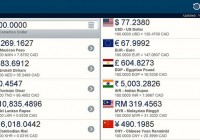New Energy Fund Seeks To Capitalize On Sector Dislocations
The North American energy landscape is changing rapidly, as the shale boom that led to record production and U.S. inventory levels is being followed by a Middle East oil conflict that is driving oil prices vastly lower. In response, OppenheimerFunds has launched the Oppenheimer SteelPath Panoramic Fund, which is designed to capitalize on the industry tumult with a long-term, value-oriented approach to investing in all “links” in the North American energy value chain. “We are investing in companies that are best positioned to gain long-term advantage from these shifts and deliver relative performance across different commodity price scenarios,” said Brian Watson, CFA and Director of Research at Oppenheimer SteelPath, as well as Senior Portfolio Manager for the fund, in a statement. “Our long-term investment view allows us to benefit from expected dislocations in the evolving global energy market.” Targeting More Volatility, Better Returns Mr. Watson also said he thinks the Oppenheimer SteelPath Panoramic Fund will have more volatility than the firm’s other midstream energy-focused funds, but he also expected it to generate better returns. That’s because the fund attempts to identify value by focusing strictly on small- and mid-cap companies, which tend to be more volatile, over large-cap international oil-and-gas juggernauts. In Mr. Watson’s view, this approach should allow the fund’s investors to best benefit from the “U.S. energy revolution.” “The North American energy landscape has transformed, creating a generational shift in relative competitive advantage as well as new opportunities across the entire energy value chain,” said OppenheimerFunds CIO Krishna Memani. “Brian and his team are using their extensive knowledge of the energy sector to identify durable investment opportunities for our clients.” The energy “value chain” includes: “Upstream” companies that explore for and produce oil, natural gas, and other hydrocarbons; “Midstream” companies that gather, transport, store, distribute, or market energy products; and “Downstream” companies that process, treat, or refine hydrocarbons. Total Return Focus The Oppenheimer SteelPath Panoramic Fund, which went live on November 18 of last year, will invest in all three links of this chain, as well as other energy beneficiaries – chemicals and materials manufacturers, engineering and production companies, etc., – that stand to benefit from energy-related activities. The new fund’s stated objective is to provide total return. Its shares are available in A (MUTF: EESAX ), C (MUTF: EESCX ), R (MUTF: EESRX ), Y (MUTF: EESYX ), and I (MUTF: EESIX ) classes, with respective net-expense ratios of 1.55%, 2.30%, 1.80%, 1.30%, and 1.10%. The minimum initial investment for Class I shares is $5 million – the minimum for all other classes is $1,000. For more information, visit the fund’s web page .
